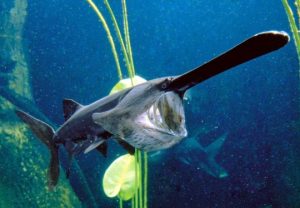When most people envision fish, they oftentimes picture an individual swimming, feeding, or perhaps interacting with conspecifics (individuals of the same species). While these behaviors and interactions are important, many miss the idea of interspecific interactions (two or more individuals from different species). Streams are complex and fish encounter many different organisms, affecting one another in different ways. Recognizing these relationships can aid us in our understanding of the aquatic ecosystem, as well as, increase general appreciation of the fish within our streams (and other water bodies). To demonstrate this, let us take a look at the Logperch darter (Percina caprodes) and a brief overview of interactions between two different species.
Logperch dwell on bottoms of streams and lakes, particularly with beds consisting of sand and gravel. This darter species can be identified by its very characteristic conical snout and striping along the body. Logperch prey upon aquatic invertebrates, using the conical snout to flip cobble and gravel to forage. This species can be found throughout Ohio as seen in the distribution map below.1-3

Snuffbox Mussel and Logperch Interaction
The Snuffbox Mussel and Logperch interact in a very interesting way. As noted before, Logperch darters dwell near the bottom of streams and lakes. While foraging, Logperch can become entrapped by Snuffbox Mussels. The Snuffbox Mussel clamps the snout or head of the Logperch. Why does this interaction occur? Is it a protective measure for the mussel?
While this may seem strange, the Snuffbox mussel has ulterior motives. The Logperch acts as a host for the mussel larvae (called glochidia). The mussel will clamp down on the Logperch and release the glochidia, which in turn, uses the gills of the Logperch for development. Once the glochidia is released, the Snuffbox mussel releases the Logperch. Demonstration of this phenomenon can be seen in the following video:
The glochidia remain on the Logperch while developing for approximately 3 weeks. Although this ‘ride’ may seem short and perhaps insignificant, it is critical for Snuffbox Mussel development. This interaction drives the propagation of another species.4-6
Round Goby and Logperch
Another example of interspecific interaction can be seen between the Logperch and Round Goby (Neogobius melanostomus). The Round Goby is an invasive species, originating from the Black Sea. It is thought they were brought to North America through ballast ships.7 The addition of Round Gobies to North American habitats have affected many species, including Logperch. Balshine, et al. showed a displacement of Logperch by Round Gobies through displays of aggression (see graph below). This negative interaction is thought to be due to competition for both habitat and food.7 Round Gobies are also territorial, which cause displacement of Logperch, as well.


Why does this matter?
In order maintain healthy ecosystems, we must understand both the biology/life history of a given species, as well as, the relationships between species in a given system. By understanding the complexity, we will be more equipped to manage accordingly. For example, if Logperch darters show a decline, managers are able to expect mussels to be impacted, as well. The examples given for the Logperch are just two of many interactions. Also, by understanding interspecific interactions, we can gain appreciation for the beauty of our systems.
1.Becker, G.C. 1983. Perch family- Percidae. Pages 869-954. Fishes of Wisconsin. University of Wisconsin Press, Madison, Wisconsin.
2.Spalding, W. 2006. Percina Caprodes (Online), Animal Diversity Web. Accessed November 02, 2017 at http://animaldiversity.org/accounts/Percina_caprodes/.
3.Zimmerman, B. and Division of Wildlife. N.d. Stream Fishes of Ohio field guide (Online), Division of Wildlife. Accessed November 02, 2017 at https://wildlife.ohiodnr.gov/portals/wildlife/pdfs/publications/id%20guides/pub5127.pdf.
4.U.S. Fish and Wildlife Service. 2016. Snuffbox (freshwater mussel) Epioblasma triquetra (Online), U.S. Fish and Wildlife Service. Accessed November 02, 2017 at https://www.fws.gov/midwest/endangered/clams/snuffbox/SnuffboxFactSheet.html.
5.Schwalb, A.N., M.S. Poos, and J.D. Ackerman. 2011. Movement of Logperch-the obligate host fish for endangered snuffbox mussels: implications for mussel dispersal. Aquatic sciences 73: 223–231.
6.Datnow, B. 2011. Snuff Box Mussel (Video). Youtube, Accessed November 02, 2017 at https://www.youtube.com/watch?v=0V6V4daH_Ik&feature=youtu.be.
7.Kornis, M.S., N. Mercado-Silva, M.J. Vander Zanden. 2012. Twenty years of invasion: a review of round goby Neogobius melanostomus biology, spread and ecological implications. Journal of Fish Biology 80: 235–285.
8.Balshine, S., A. Verma, V. Chant, and T. Theysmeyer. 2005. Competitive interactions between Round Gobies and Logperch. Journal of Great Lakes Research 31: 68–77.
9.Sea Grant Michigan. N.d. Round Goby Neogobius melanostomus. Accessed November 02, 2017 at http://www.miseagrant.umich.edu/explore/native-and-invasive-species/species/fish-species-in-michigan-and-the-great-lakes/round-goby/nggallery/thumbnails.







